A few years ago I had to follow a gluten-free diet for a while. The biggest challenge for me was that I love freshly baked bread! A warm crust with thick butter and a little salt... How I missed that! Because even though there is packaged gluten-free bread in almost all grocery stores, it still remains packaged bread. In addition, the list of ingredients of these breads scared me.
Without breaking down the ingredients again, the country bread from a leading manufacturer has 22 ingredients. Else even 27!
Water, sunflower seeds, corn starch, tapioca starch, rice flour, whole rice flour, flaxseed, yeast, sourdough (rice flour, water), canola oil, thickeners (hydroxypropylmethylcellulose, xanthan gum, sodium carboxymethylcellulose), salt, gluten-free barley malt extract, sesame seeds, dietary fiber (potato fiber, psyllium seed fiber), psyllium seed hulls, sugar beet syrup, sourdough (quinoa flour, water), sugar, caramelized sugar, lactose-free skim milk powder, emulsifier (mono- and diglycerides of fatty acids).
Especially thickeners and emulsifiers have no business in my bread.
Gluten-free bread made from natural ingredients
For me, a bread should contain flour, water and salt. Possibly some yeast, if no sourdough is used. Sometimes sugar or nuts and seeds. So I don't like to use much more than one hand to count the ingredients (not counting the water). I don't need to, either, because I bake an excellent bread from buckwheat. And if you consider seeds and nuts as one, it even has under 5 ingredients. The greatest thing is that not only do I like the bread, but even my younger son's best friend, who is also on a gluten-free diet due to celiac disease. And that means a lot, because the child has previously devoured mainly sweet wheat pancakes.
The advantages of my gluten-free buckwheat bread
- it is made from only a few ingredients that are widely available
- it is super easy to prepare
- you can freeze it in portions and defrost it in the toaster in a flash
- due to the many minerals of buckwheat, lecithin, vitamins B1, B2 and B6, this bread is particularly easy to digest
- kids love it!
I did not invent this bread, but based it on the recipe by Nele Liivlaid from nutriplanet. I particularly love it because it is baked from buckwheat grains, not buckwheat flour. I enjoy buckwheat flour in the form of galettes, but otherwise it's not really my cup of tea. And, of course, I really love that the grains are pre-fermented and thus leavened. Nele's version is sugar free. You can do that, of course, and leave out the sweetener - I like it better when the flavors are balanced, which is why some sugar belongs in this bread. And in cookies some salt. But that's another story and shall be told another time.
INGREDIENTS
- 435 gr. hulled buckwheat grains
- 300 gr. water
- 1 tsp. rock salt
- 1 tbsp. raw cane sugar, honey or molasses
- 3 tsp. flax or sesame seeds *
- 3 tbsp. chopped nuts, mixed *
* You can combine and vary the nuts and seeds depending to your liking. Sunflower seeds and pumpkin seeds taste very good. You can also include dried herbs, olives or dried tomatoes!
PREPARATION
Wash the buckwheat grains well and soak them for 5-6 hours to sprout slightly. Drain thoroughly in a colander for a few minutes. Draining is important so that the dough does not become too runny later. Do not rinse, as this would wash away some of the active enzymes.
Blend the drained buckwheat grains with the water until smooth. I usually do this with a hand mixer. If you like it particularly crunchy, you can also set aside 50-70 grams of buckwheat seeds and fold them back in after pureeing.
Place in a glass or ceramic bowl (plastic works too, metal is not suitable) with a cloth to protect against critters and let rise overnight at about 35°C. This works well, as with all sourdoughs, in the oven with the light on. In the morning, the dough should be leavened by fermentation. You can tell because it has risen and fine bubbles are forming. If the dough is not yet bubbling, just let it ferment a little longer.
Carefully add other ingredients
Salt, sugar and the seeds, nuts or herbs are gently folded in so that the dough does not collapse again due to too vigorous stirring.
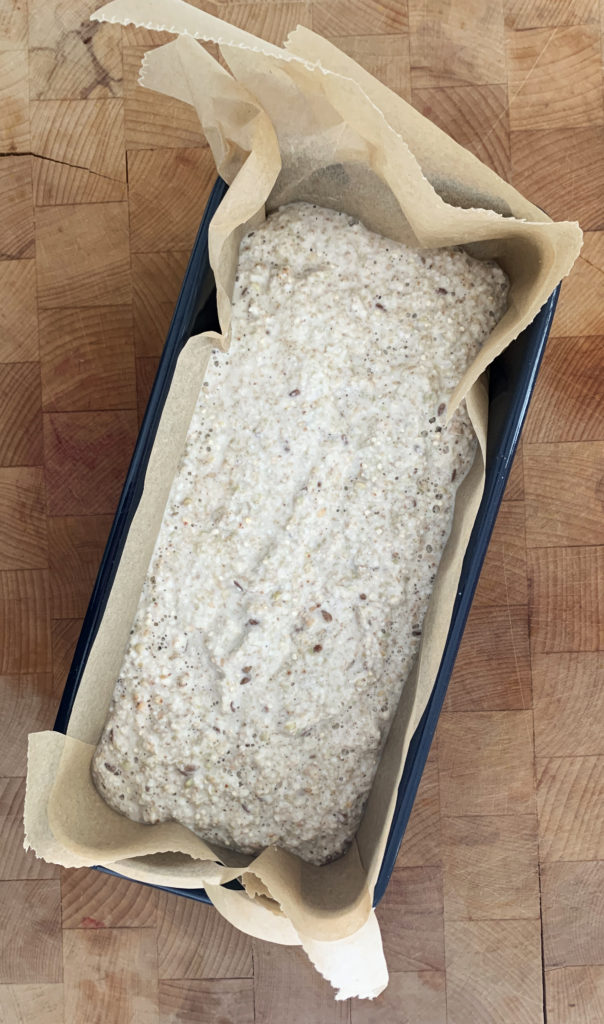
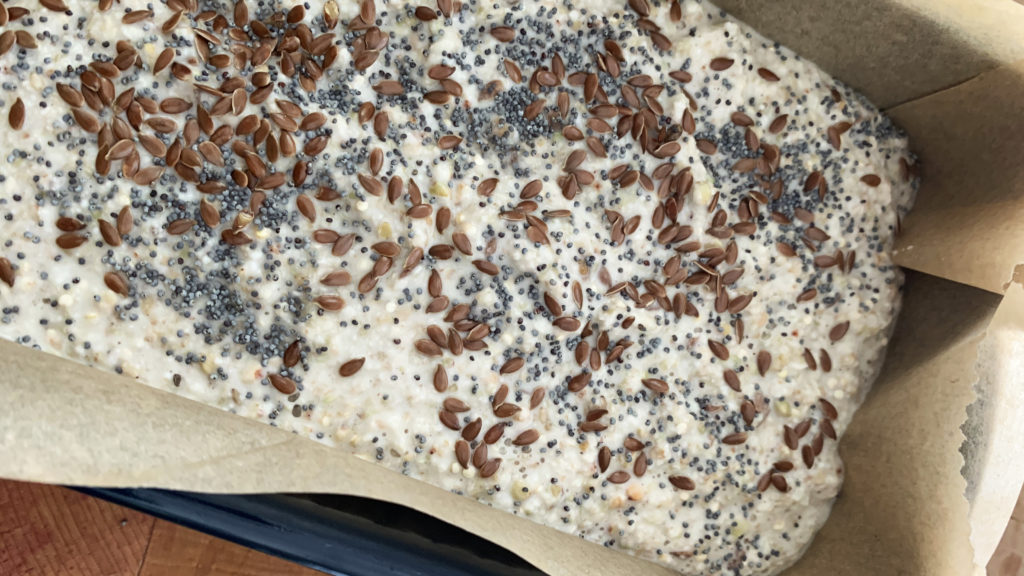
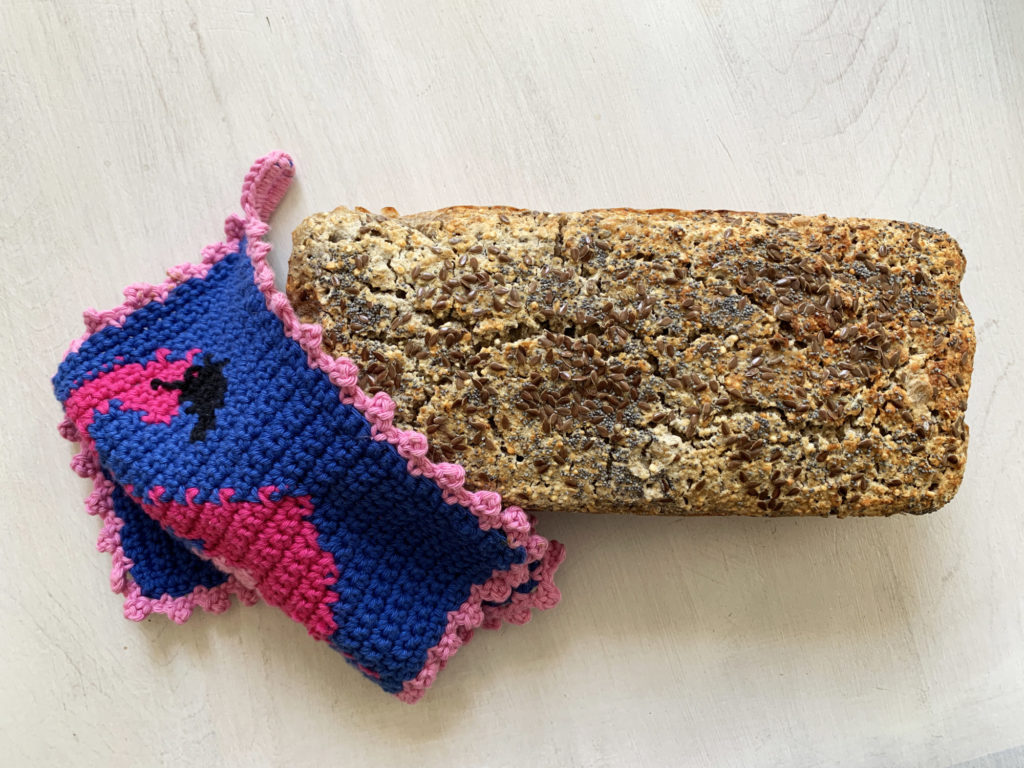

Line a loaf pan with baking paper, or use a silicone mold. Pour the dough and place in the oven. Heat the oven with the bread to 175°C and bake for 1 ¼ hours.
Immediately after baking, remove from the mold and carefully remove the baking parchment. This is important so that the residual moisture can evaporate. Allow to cool for at least 1 hour before cutting.
One is many! Two examples of buckwheat bread flavors.
On the left, a fresh buckwheat sourdough bread with sesame and flax seeds and gluten-free oat grains. The dark color comes from using molasses. On the right, a freshly toasted slice with pumpkin seeds and quinoa. This great bread just never gets boring!
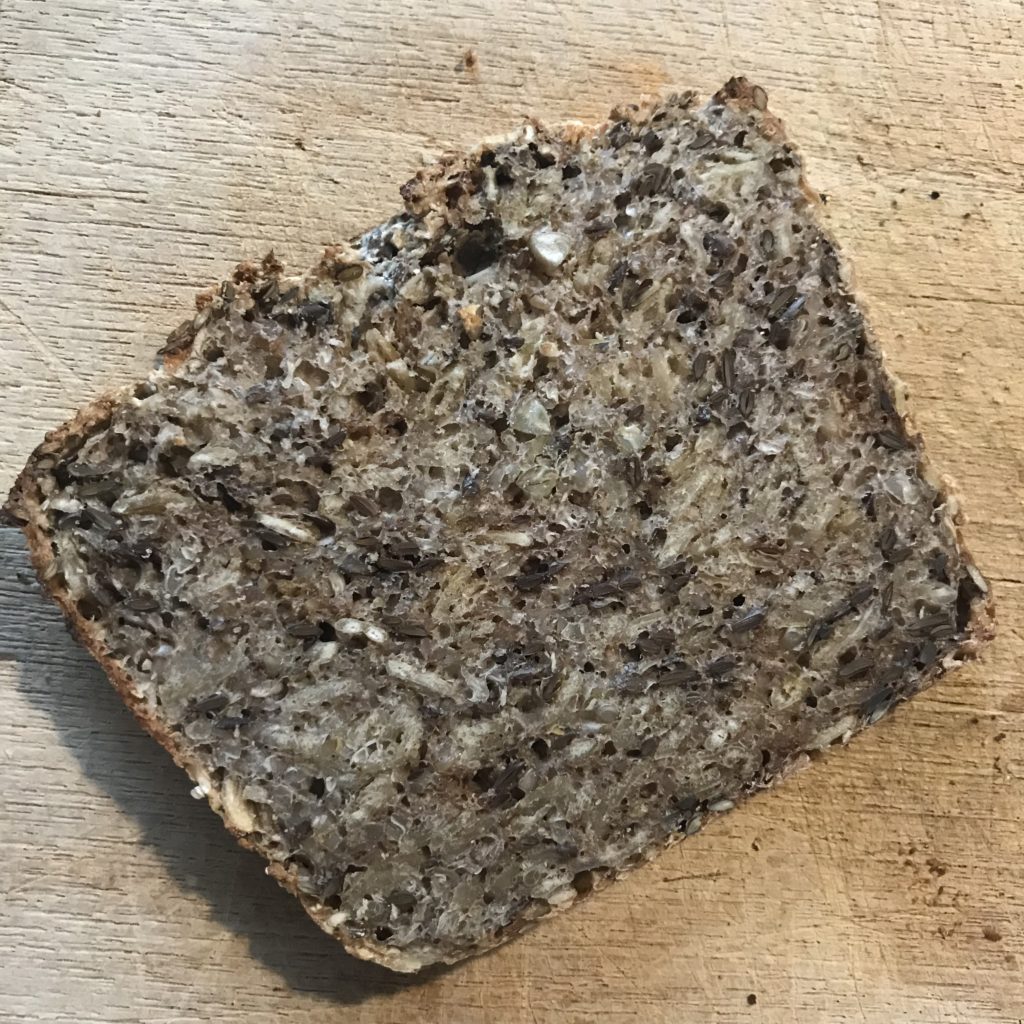
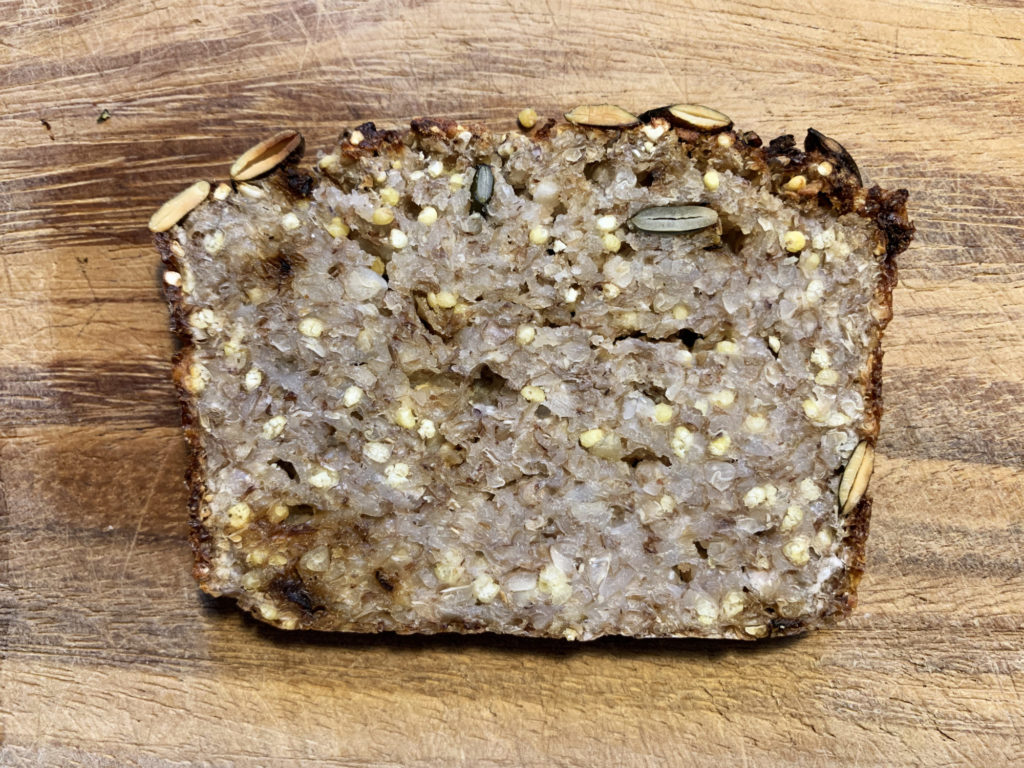
How long does the buckwheat bread stay fresh?
The buckwheat bread keeps fresh in the bread box for 2-3 days, in the refrigerator up to 10 days, and can be frozen very well in individual slices. To eat, simply put the slices directly from the freezer into the toaster.
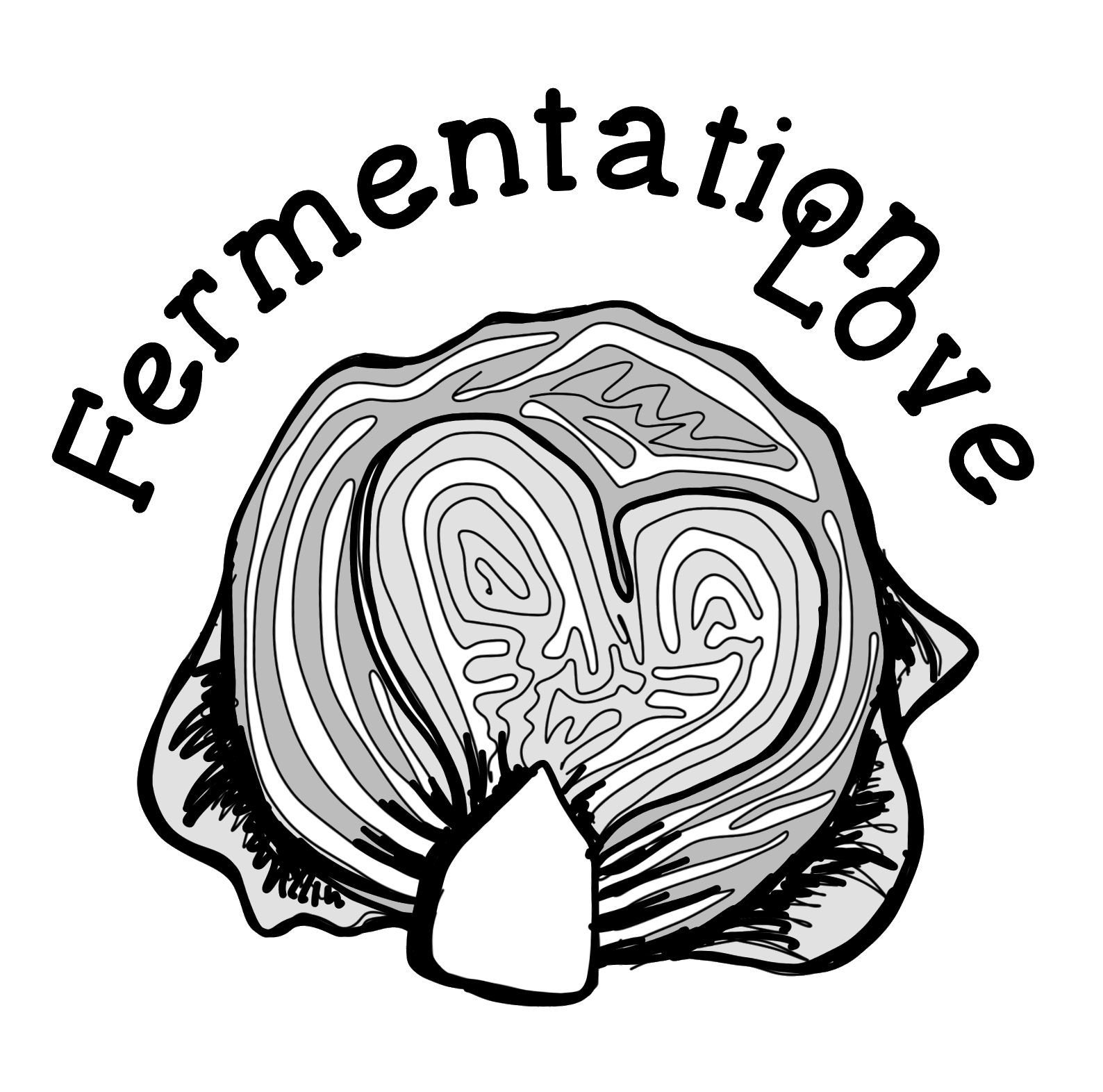
Moin,
hab gestern das Rezept probiert und hat super geklappt…Hätte nur noch länger stehen können, weil es keine 35° waren…schmeckt super und hält erstaunlich gut zusammen. Werde ich sicherlich so oder so ähnlich noch öfters machen!
Eine Frage nur: Weichst du die Körner in 300gr Wasser ein oder kommt die Menge nach dem Abtropfen noch dazu? Mir kam der Teig dann doch recht feucht vor und ich hab kein extra Wasser nach dem Abtropfen mehr hinzugegeben…(Habe allerdings einfach nach Baugefühl Wassermenge zu einlegen genutzt) .
Ansonsten super Seite mit inspirierenden Rezepte, die mich mal wieder voll angefixt haben 🙂 . Find’s auch eigentlich schön, dass es nicht so suuuuper viele sind, dann ist man als Anfänger nicht gleich überfordert mit der Auswahl.
Hej Simon,
vielen Dank für das tolle Kompliment! Ich freue ich, wenn ich Dich inspirieren kann.
Die Menge Wasser ist nur zum Einweichen. Wie ich im Rezept geschrieben habe, ist es wichtig, den Buchweizen danach gründlich abzutropfen. Dein Instinkt war genau richtig! Also, nächstes Mal einfach ab ins Sieb mit den eingeweichten Körnern, abwarten und dann weiter verarbeiten. Ich geh manchmal zwischendurch einfach ‘ne runde Laufen 😁
Gutes Gelingen!
Katsu
EDIT 08.11.2022: Durch Schroeders Frage fiel mir hier auf, dass natürlich die 300ml nach dem Abtropfen vor dem Pürieren hinzugefügt werden müssen, wenn Du die Grütze vorher hast abtropfen lassen. Das Brot wird besser, wenn es gründlich abtropft, aber wenn es Dir gut geschmeckt hat, ignorier’ meine Meinung einfach 😉
Zitat: »Die abgetropften Buchweizenkörner mit dem Wasser zu einem glatten Teig pürieren. Ich mache das meistens mit dem Handmixer. «
jedsedle habt ihr beiden mich völlig verwirrt. “Abgetropft … MIT dem Wasser … verrühren” = lese ich so, dass ich die angeg. 300 g Wasser NACH dem Abtropfen hinzufügte und dann rührrühr ….
Laut den beiden Kommentaren war dies jedoch falsch (?) Mein 1. Brot ist dennoch was geworden. Glück gehabt?
*Bitte um Aufklärung* … (Abgetropft ohne Wasser oder mit zusätzlichem W. verrühren) da der ©apie®schutz für mich zu hoch
Hej Schroeder,
danke für’s Nachhaken, ich habe meine Antwort an Simon ergänzt. Sie war verwirrend, weil schlicht falsch. Also, am besten wird das Brot, wenn Du die Grütze abtropfen lässt und danach frisches Wasser zum Pürieren nimmst. Vielleicht schmeckt es Dir aber auch anders, das wäre natürlich ressourcenschonender und somit besser.
Gutes Gelingen!
Katsu